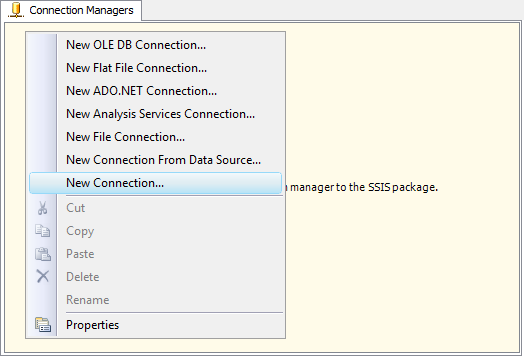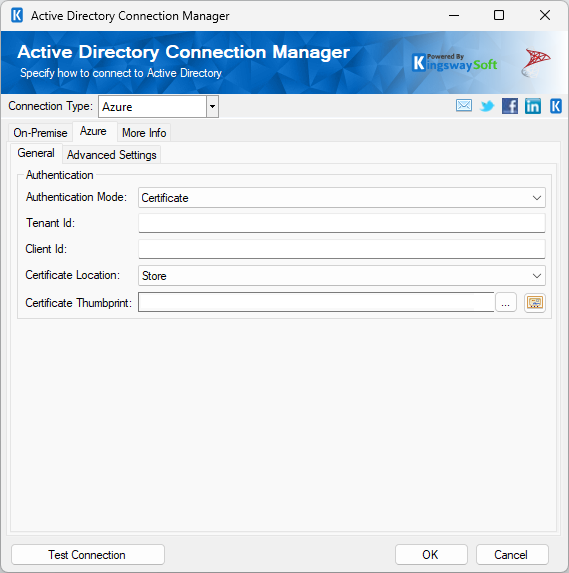Using the Active Directory Connection Manager
The Active Directory Connection Manager is an SSIS connection manager component that can be used to establish connections with Microsoft Active Directory and Microsoft Azure Active Directory.
To add an Active Directory connection to your SSIS package, right-click the Connection Manager area in your Visual Studio project, and choose "New Connection..." from the context menu.

You will be prompted with the "Add SSIS Connection Manager" window. Select the "ActiveDirectory" item to add the new Active Directory connection manager.

The Active Directory Connection Manager contains the following three pages which configure how you want to connect to Microsoft Active Directory. There is a drop-down on the component that allows you to switch between Azure or On-Premise Active Directory.
- On-Premise
- Azure
- More Info
On-Premise Page
The On-Premise page on the Active Directory Connection Manager allows you to specify the settings to build the connection with Microsoft Active Directory.

- Active Directory Domain
-
- Domain
-
The Domain field lets you specify the domain name of the directory to connect to. The domain name should be a fully qualified name.
- Authentication
-
- User Name
-
The User Name field allows you to specify the user account that you want to use to connect to your Active Directory. Depending on how you want to manipulate your data, the user account needs to have proper privileges to do so.
- Password
-
The Password field allows you to specify the password for the above user account in order to authenticate with Active Directory.
Note: By default, the Password is not shown in the Active Directory connection manager's ConnectionString property. This is done by design for security reasons. However, you can include it in your ConnectionString if you want to parameterize your connection manager. The format would be Password=myPassword; (make sure you have a semicolon as the last character). It can be placed anywhere in the ConnectionString property.
- Context Binding
-
By default, 'Negotiate', 'Sealing', and 'Signing' are checked. You can specify the Context Binding according to your Active Directory Setup.
- Test Connection
-
After all the connection information has been provided, click the "Test Connection" button to test if the user credentials entered are correct.
Azure Page
The Azure page on the Active Directory Connection Manager allows you to specify the settings to build the connection with Azure Active Directory. This page has two additional sub-pages:
- General
- Advanced Settings
General Sub-Page

- Authentication
- There are three authentication modes available
-
- Authorization Code
- Certificate (since v25.1.1)
- Client Credentials (since v25.1.1)
-
- Generate Token File (Available for Authorization Code authentication mode)
-
This button will open a dialog in order to generate a new Token File.

- App Info
-
- Tenant ID
-
The Tenant Id allows you to specify a valid tenant id detail.
- Client ID
-
The Client ID option allows you to specify the GUID value that identifies a client application in Microsoft Application Registration Portal. Note that you need to register your application via this portal in order to generate your Client Id.
- Client Secret
-
The Client Secret option allows you to specify the client secret that you have requested from Microsoft Application Registration Portal. You can find the Password/Public Key under Application Secret Section in the portal.
- Scope
-
The Scope option allows you to specify the permissions required to be assigned to the token.
- PKCE
- Enable this option is Proof Key for Code Exchange is required in your instance.
- Redirect URI
-
The Redirect URI option allows you to specify the Redirect URL to complete the authentication process.
- Sign In & Authorize
-
- Use Default Browser to Sign In
-
When this option is checked the Sign In and Authorize button will open your default web browser in order to complete the authentication. When this option is unchecked, the Sign In and Authorize button will complete the entire authentication process inside the toolkit.
- Sign In and Authorize
-
This button allows you to log in to the service endpoint and authorize your app to generate a token.
- Password
-
This option allows you to assign a new password for the token file which will be created.
- Save To Token File
-
This option allows you to specify the location of where the token file will be saved.
- Path to Token File
-
This option allows you to specify the path to the token file on the file system. Now, you can work with SAS URL as well, for the token file path.
- Token File Password
-
This option allows you to specify the password of the selected token file.

- Tenant Id (Available for Client Credentials authentication mode)
-
Specify the tenant Id for the Authentication.
- Client Id (Available for Client Credentials authentication mode)
-
Specify the Client Id from your OAuth App.
- Client Secret (Available for Client Credentials authentication mode)
-
Specify the Client secret generated for the authentication.

Certificate Location (Available for Certificate authentication mode)-
Pick the Certificate location between Store and File System
- Certificate Thumbprint (Available for Certificate authentication mode)
-
This is available when Store is chosen as Certificate location. Choose the certificate and view and validate it for thumbprint.
- Certificate Password (Available for Certificate authentication mode)
-
This option is available when Certificate Location is chosen as File System. Enter the password for the selected certificate.
- Path to Certificate (Available for Certificate authentication mode)
-
This option is available when Certificate Location is chosen as File System. Click on the Ellipsis to browse and pick the certificate.
Advanced Settings Sub-Page

- Proxy Server Settings
-
- Proxy Mode
-
The Proxy Mode option allows you to specify how you want to configure the proxy server setting. There are three options available.
- No Proxy
- Auto-detect (Using system-configured proxy)
- Manual
- Proxy Server
-
Using the Proxy Server option, you can provide a proxy server to connect to Azure Active Directory.
- Port
-
The Port option allows you to specify the port number of the proxy server for the connection.
- Proxy authentication required
-
Select this option if your proxy server requires authentication. Doing so will activate the Username and Password fields below.
- Username
-
The Username option allows you to specify the proxy user account.
- Password
-
The Password option allows you to specify the proxy user’s password.
Note: Proxy Password is not included in the Active Directory connection manager's ConnectionString property by default. This is done by design for security reasons. However, you can include it in your ConnectionString if you want to parameterize your connection manager. The format would be ProxyPassword=myProxyPassword; (make sure you have a semicolon as the last character). It can be anywhere in the ConnectionString.
- Misc
-
- Timeout (secs)
-
The Timeout (secs) option allows you to specify a timeout value in seconds for the connection. The default value is 120 seconds.
- API Throttling Rate
-
The API Throttling Rate option allows you to restrict how many requests you want to send to Azure Active Directory per second. This rate is set to 10 and you can adjust upward from there to optimize your throughput without exceeding the rate limit.
- Retry on Intermittent Errors
-
This is an option designed to help recover from possible intermittent outages or disruption of service. It prevents the integration process from stopping due to temporary issues. Enabling this option will allow service calls to be retried upon certain types of failure. A service call may be retried up to 3 times before an exception is fired. Retries occur after 0 seconds, 15 seconds, and 60 seconds.
Warning: We have designed our retry feature carefully such that the retry should only occur when it is deemed safe to do so; however, in some occasions, such retry service calls could result in the creation of duplicate data.
More Info Page
The More Info page shows some basic information about the toolkit. On this page, you can find the version information of the toolkit.


